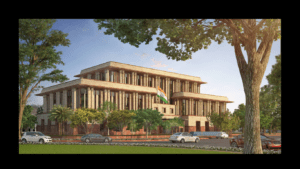Introduction
Food security is fundamental to the health, well-being, and economic stability of any nation. In a populous country like India, ensuring access to adequate, nutritious, and affordable food for all citizens is both a challenge and a priority. Food security goes beyond mere food production; it encompasses availability, accessibility, and affordability.
This blog explores how food security is ensured in India, examining the policies, programs, and measures that address this critical issue while highlighting the challenges and opportunities for improvement.
Understanding Food Security
What is Food Security?
The Food and Agriculture Organization (FAO) defines food security as a state where all people, at all times, have physical and economic access to sufficient, safe, and nutritious food to meet their dietary needs and preferences for an active and healthy life.
Components of Food Security:
- Food Availability: Adequate food production and supply chains.
- Food Accessibility: Economic and physical access to food.
- Food Utilisation: Proper use of food, including nutritional value and food safety.
- Stability: Consistent access to food without fluctuations due to economic, environmental, or political factors.
Challenges to Food Security in India
- Population Pressure:
- India is the second most populous country, leading to high demand for food.
- Poverty and Inequality:
- Despite economic growth, significant sections of the population live below the poverty line, affecting their ability to afford food.
- Climate Change:
- Erratic weather patterns, droughts, and floods impact agricultural productivity.
- Agricultural Challenges:
- Small landholdings, lack of modern equipment, and dependence on monsoons hinder productivity.
- Food Wastage:
- A substantial amount of food is wasted during production, storage, and transportation.
- Nutritional Deficiency:
- Focus on calorie intake often overlooks the need for balanced nutrition, leading to malnutrition.
Government Initiatives for Ensuring Food Security
To combat food insecurity, the Indian government has implemented a range of policies and programs.
1. Public Distribution System (PDS):
The PDS is a cornerstone of India’s food security mechanism. It provides subsidised food grains to economically weaker sections through a network of Fair Price Shops (FPS).
- Coverage: Over 800 million people benefit from the PDS.
- Subsidised Items: Rice, wheat, sugar, and kerosene.
- Challenges: Leakages, corruption, and inefficiency in distribution.
- Reforms: Digitisation of ration cards and biometric authentication under the National Food Security Act (NFSA).
2. National Food Security Act (NFSA), 2013:
Also known as the Right to Food Act, the NFSA is a landmark legislation aimed at providing food security.
- Provisions:
- Ensures food grains at subsidised prices to 75% of rural and 50% of urban populations.
- Special focus on pregnant women, lactating mothers, and children through Mid-Day Meal (MDM) and Integrated Child Development Services (ICDS).
- Targeted Coverage: Priority households and Antyodaya Anna Yojana (AAY) beneficiaries.
3. Integrated Child Development Services (ICDS):
Launched in 1975, ICDS aims to improve the nutritional status of children under six years of age and their mothers.
- Key Services:
- Supplementary nutrition.
- Immunisation.
- Health check-ups and pre-school education.
4. Mid-Day Meal Scheme (MDMS):
This school meal program is designed to enhance enrolment, retention, and nutritional levels among school children.
- Impact:
- Provides hot cooked meals to children in government and aided schools.
- Alleviates classroom hunger and improves educational outcomes.
5. Minimum Support Price (MSP):
The government announces MSP for various crops to ensure fair prices for farmers and incentivise food grain production.
- Benefits:
- Protects farmers from price volatility.
- Encourages cultivation of food grains critical to food security.
6. Food Corporation of India (FCI):
Established in 1965, the FCI plays a vital role in procurement, storage, and distribution of food grains.
- Functions:
- Ensures buffer stock for emergencies.
- Supports the PDS and NFSA.
7. Other Initiatives:
- National Nutrition Mission (POSHAN Abhiyaan): Focuses on eradicating malnutrition.
- National Mission for Sustainable Agriculture (NMSA): Promotes sustainable farming practices.
- Pradhan Mantri Garib Kalyan Anna Yojana (PMGKAY): Free food grain distribution during emergencies like COVID-19.
Role of Technology in Food Security
- Smart Agriculture:
- Use of drones, IoT, and AI to monitor crops and enhance productivity.
- E-Governance in PDS:
- Digitisation of supply chains and ration cards reduces corruption.
- Cold Storage Facilities:
- Prevents post-harvest losses.
- Online Marketplaces:
- Platforms like e-NAM connect farmers to buyers, ensuring fair prices.
Food Security and Sustainable Development
India’s approach to food security aligns with the United Nations’ Sustainable Development Goals (SDGs):
- Goal 2 – Zero Hunger:
- Policies focus on eliminating hunger and improving nutrition.
- Goal 12 – Responsible Consumption and Production:
- Encourages reduction in food wastage.
- Goal 13 – Climate Action:
- Promotes climate-resilient agriculture.
Success Stories in India
- White Revolution:
- Spearheaded by Amul, it made India the largest producer of milk and dairy products.
- Green Revolution:
- Boosted wheat and rice production in the 1960s and 70s.
- Operation Greens:
- Ensures price stability for tomatoes, onions, and potatoes (TOP crops).
Challenges in Achieving Comprehensive Food Security
- Inequality in Access:
- Marginalised communities often face barriers to food access.
- Climate Change:
- Increased vulnerability to droughts and floods.
- Food Adulteration:
- Impacts the quality and safety of food.
- Economic Disparities:
- Rising food prices affect affordability for the poor.
Recommendations for Strengthening Food Security
- Investing in Agriculture:
- Promote sustainable farming and provide financial support to farmers.
- Innovations in Supply Chains:
- Enhance storage, transport, and distribution systems to minimise wastage.
- Strengthening Welfare Programs:
- Expand coverage and improve efficiency of PDS, MDM, and ICDS.
- Community Participation:
- Encourage local involvement in food production and distribution.
- Nutrition Awareness:
- Educate people about balanced diets and food safety.
Conclusion
Food security in India is a multi-dimensional challenge that requires a comprehensive and collaborative approach. While significant strides have been made through policies like NFSA, PDS, and various welfare schemes, persistent issues like poverty, climate change, and inefficiencies in supply chains need to be addressed.
By leveraging technology, promoting sustainable practices, and ensuring equitable distribution, India can move closer to achieving universal food security. A resilient food system is not just an economic necessity but also a moral imperative to ensure that every citizen has access to safe, nutritious, and affordable food.




